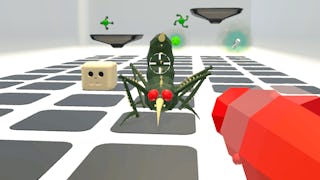In this course, you will examine how storytelling acts as a vital mechanism for driving video gameplay forward. Looking at several historical and contemporary games, you will be asked to evaluate and interpret different story styles with the goal of identifying themes and procedures for your own game ideas. We'll examine traditional narrative story processes, such as three-act structure, and how they fit into game story flows and the strategic elements of gameplay. Ultimately, you will learn how to define character, setting, and structure to create a compelling game concept.

3 days left: Get a Black Friday boost with $160 off 10,000+ programs. Save now.


Story and Narrative Development for Video Games
This course is part of Game Design: Art and Concepts Specialization

Instructor: Dariush Derakhshani
50,876 already enrolled
Included with
(1,269 reviews)
Skills you'll gain
Details to know

Add to your LinkedIn profile
See how employees at top companies are mastering in-demand skills

Build your subject-matter expertise
- Learn new concepts from industry experts
- Gain a foundational understanding of a subject or tool
- Develop job-relevant skills with hands-on projects
- Earn a shareable career certificate

There are 4 modules in this course
For the first week of the class, we will be analyzing the components of three-act structure using a classic fairytale as an example. We'll examine the characters in the story by figuring out their goals and the main conflict that creates a rising arc of action to keep the audience interested.
What's included
6 videos7 readings1 peer review1 discussion prompt
In this week, we will draw a parallel between last week’s discussion on rising action and how that relates to gameplay. Looking at a pair of contemporary games, we'll learn how to identify story structure and themes of rising action, just like we would with traditional stories and movies. Lastly, we’ll evaluate the role that primary and secondary characters come to play in the unveiling of a game’s story and discuss the importance of understanding how these games present their stories in the actual gameplay.
What's included
4 videos12 readings1 peer review
This week, we explore ideation techniques and learn how to consolidate our ideas into more formalized stories specifically for pushing them towards a game design. We will take a look at the importance of, and ways to refine, characters and settings as we develop an initial concept in story form first, and then next week, into a game.
What's included
4 videos8 readings1 peer review
For this last week of class, we will begin by seeing what a game design document is, and evaluate a few different templates you can use. Then, we will take the story we built in last week’s course, The Shooter, and define it as a playable game outlined in a game design document.
What's included
5 videos6 readings1 peer review
Earn a career certificate
Add this credential to your LinkedIn profile, resume, or CV. Share it on social media and in your performance review.
Instructor

Offered by
Explore more from Music and Art
 Status: Preview
Status: PreviewVanderbilt University
 Status: Free Trial
Status: Free TrialCalifornia Institute of the Arts
 Status: Free Trial
Status: Free TrialMichigan State University
 Status: Preview
Status: PreviewIllinois Tech
Why people choose Coursera for their career




Learner reviews
1,269 reviews
- 5 stars
78.89%
- 4 stars
15.98%
- 3 stars
3.46%
- 2 stars
1.18%
- 1 star
0.47%
Showing 3 of 1269
Reviewed on Jul 11, 2020
The course is really good and really educational and i would recommend people about it. Though the thing that i didn't like was that i wanted some more examples for different types of games.
Reviewed on Feb 23, 2016
I am glad that I have chosen to sign up to this course. It has open up my vision to a whole new world. Thanks so very much. The professor is engaging and the course content is fascinating.
Reviewed on Dec 13, 2015
Big fan of the last two assignments. Re-writing the game was fun, and made it more interactive with the rest of the class, seeing how others would change the story.

Open new doors with Coursera Plus
Unlimited access to 10,000+ world-class courses, hands-on projects, and job-ready certificate programs - all included in your subscription
Advance your career with an online degree
Earn a degree from world-class universities - 100% online
Join over 3,400 global companies that choose Coursera for Business
Upskill your employees to excel in the digital economy
Frequently asked questions
To access the course materials, assignments and to earn a Certificate, you will need to purchase the Certificate experience when you enroll in a course. You can try a Free Trial instead, or apply for Financial Aid. The course may offer 'Full Course, No Certificate' instead. This option lets you see all course materials, submit required assessments, and get a final grade. This also means that you will not be able to purchase a Certificate experience.
When you enroll in the course, you get access to all of the courses in the Specialization, and you earn a certificate when you complete the work. Your electronic Certificate will be added to your Accomplishments page - from there, you can print your Certificate or add it to your LinkedIn profile.
Yes. In select learning programs, you can apply for financial aid or a scholarship if you can’t afford the enrollment fee. If fin aid or scholarship is available for your learning program selection, you’ll find a link to apply on the description page.
More questions
Financial aid available,
¹ Some assignments in this course are AI-graded. For these assignments, your data will be used in accordance with Coursera's Privacy Notice.

